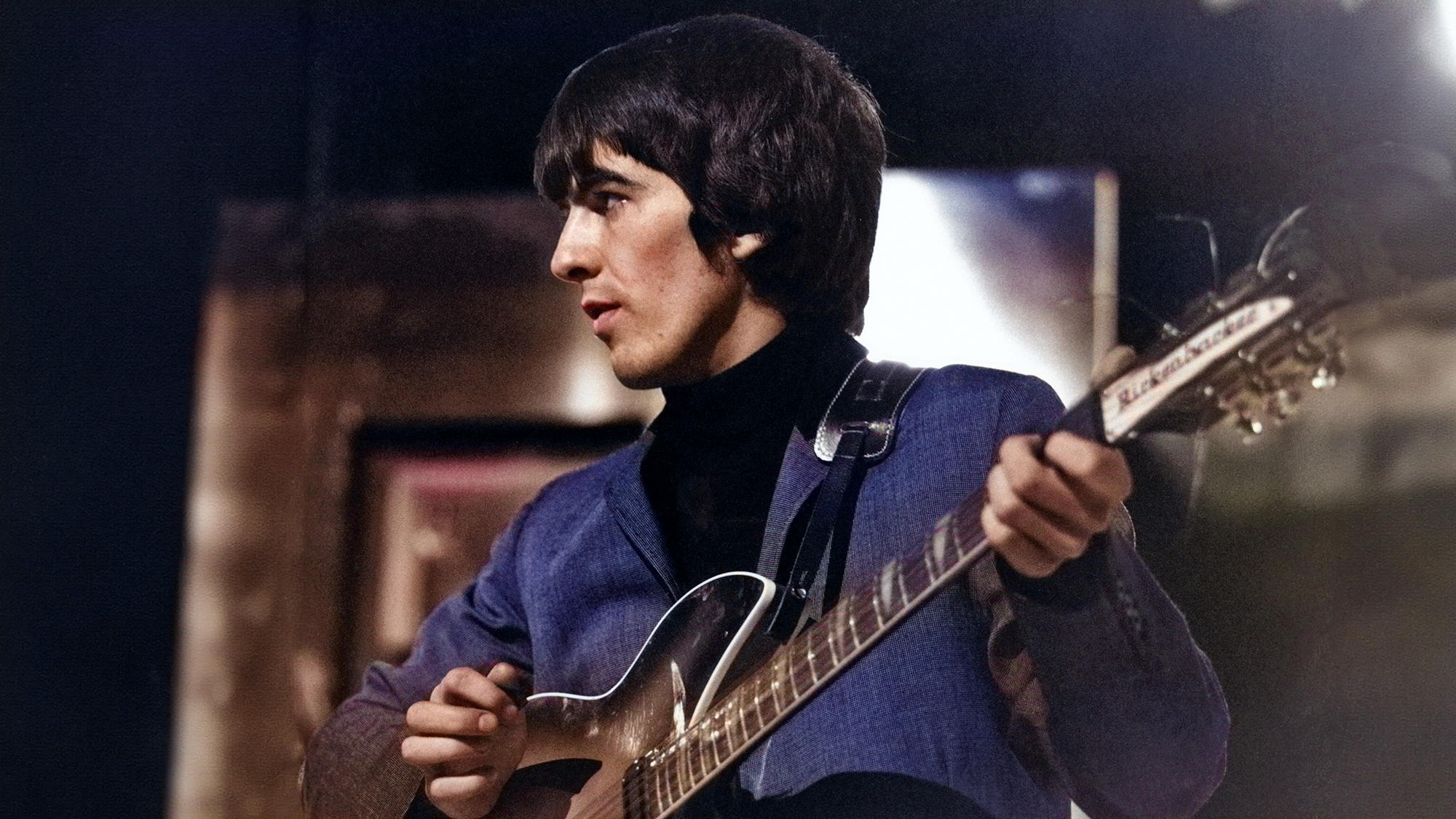The Ultimate Brian May Lead Guitar Lesson
Learn the signature licks and tricks of Queen’s legendary guitarist
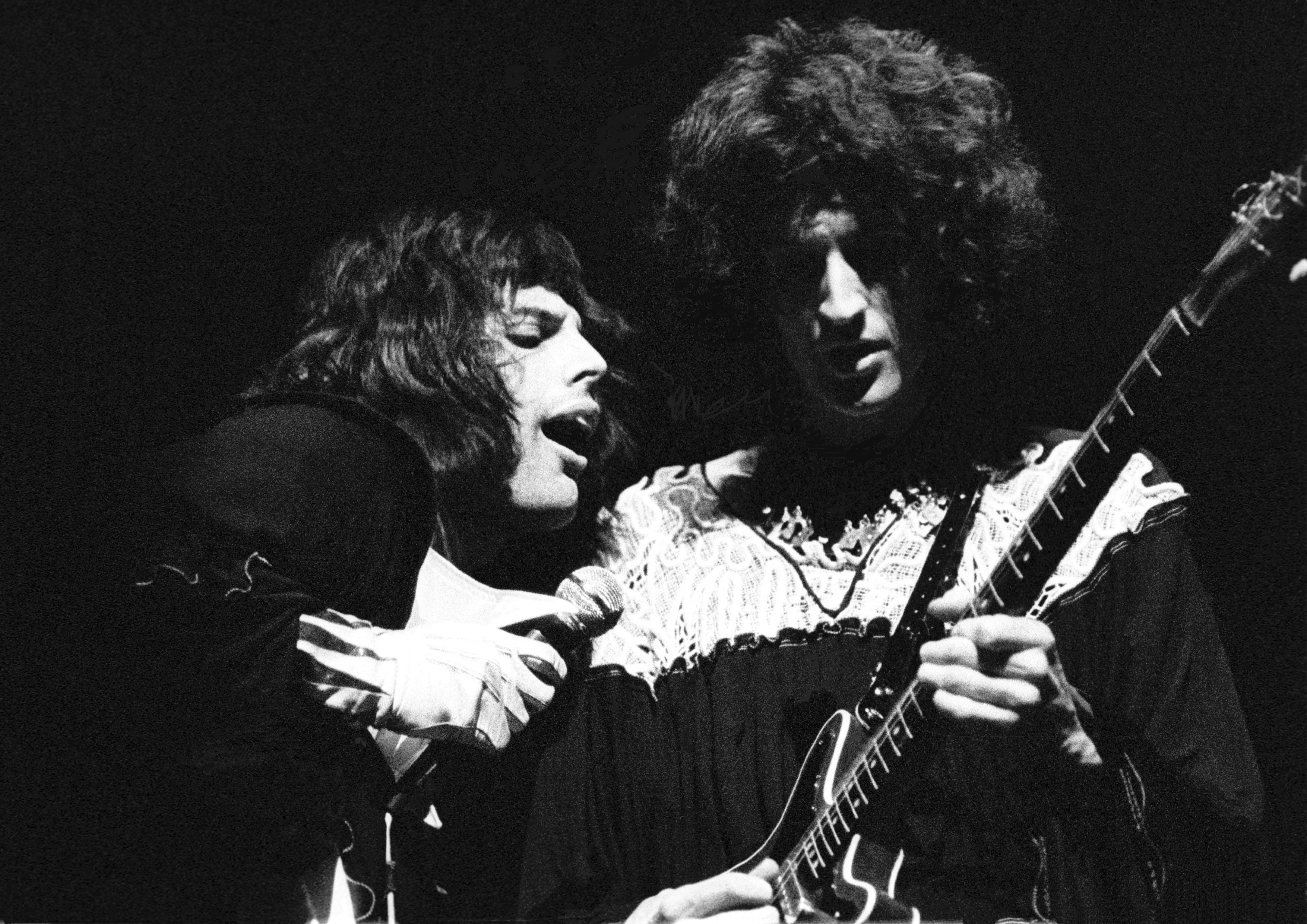
Queen’s Brian May is a nimble-fingered and technical player with a keen grasp of harmony, but his melodic, singable approach to both riffs and solos means any player can learn from his style.
In this lesson, we’ll highlight the key elements of Brian’s signature lead playing voice, which is informed by a diverse mix of musical influences ranging from blues, metal, classical and even traditional Dixieland jazz.
The licks presented herein demonstrate a variety of techniques, including the kind of single-string tapping, scalar picking approaches and soulful, melodic lead work that Brian is noted for applying tastefully in such songs as “Bijou” and “Who Wants to Live Forever,” all delivered with singing finger vibrato and string bends.
We’ll also take a look at May’s clever use of a delay effect to create harmony leads live.
TAPPING
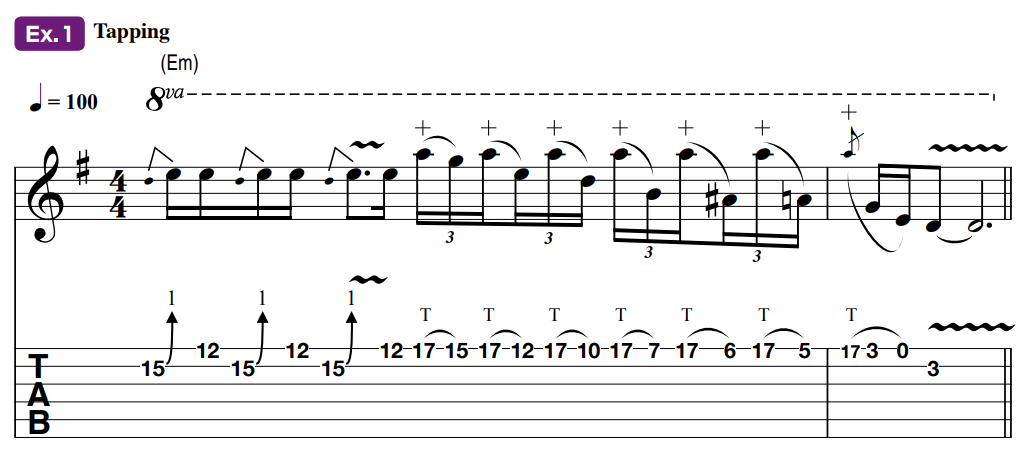
Ex. 1 employs a single-string tapping approach inspired by what Brian plays in “One Vision,” the opening track from A Kind of Magic (1986).
To perform the repeating bend lick on beats 1 and 2, use alternate picking and your fret hand’s middle finger to bend the B string, supported one fret below by the middle finger (3+2 reinforced bend fingering).
Then move your pick hand’s middle finger into position to repeatedly tap and pull-off from the A note on the high E string’s 17th fret as your fret hand continually shifts down the neck to catch each pull-off from a successively lower fret.
All the latest guitar news, interviews, lessons, reviews, deals and more, direct to your inbox!
Be sure to fret each lower note before pulling off to it. And when releasing each tap, flick the string slightly downward (toward the floor), in order to keep the string vibrating and maintain a good, even amount of volume note to note.
The descending notes are derived from the E blues scale (E, G, A, Bb, B D), so this lick works well over most E-based rock riffs.
ALTERNATE-PICKED LICKS
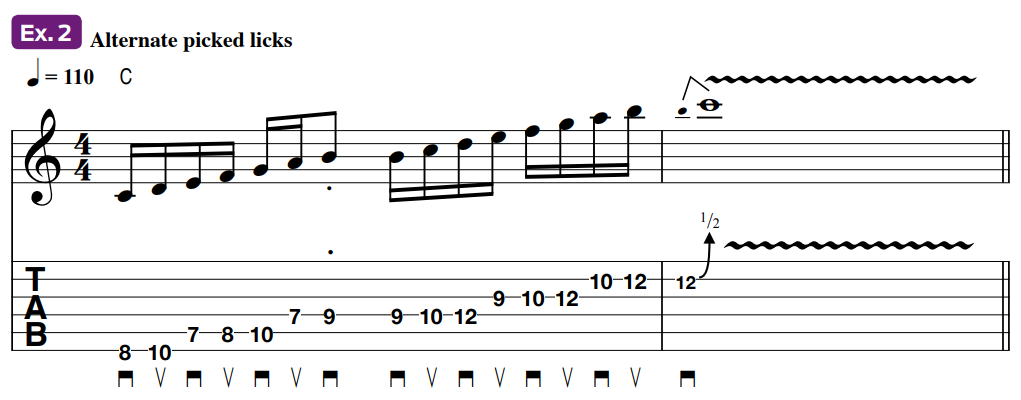
Ex. 2 is a classically flavored Brian May-style ascending run performed with alternate-picking, using notes from the C major scale (C, D, E, F, G, A).
If you want to play a harmony part above it, use diatonic 3rds or 5ths in the key of C, starting on E or G and walking up the scale in lock-step fashion. Notice the position shift on beat 3 of bar 1, which is crucial for continuing the climb, and the use of vibrato with a half-step bend on the final note.
This type of vibrato, which is called bend vibrato, is the most expressive and vocal-like guitar technique, and it’s a hallmark of May’s guitar voice and touch.
The key to performing this technique well is to first bend up to the prescribed target pitch, which in this case is C, then proceed to partially release the bend, by about a quarter tone (which is half of a half step), then bend it back up to the target pitch.
Do this repeatedly in a quick, even rhythm, but not too fast. (Recall the sound of a great singer holding and shaking a note.)
EXPRESSIVE STRING BENDS
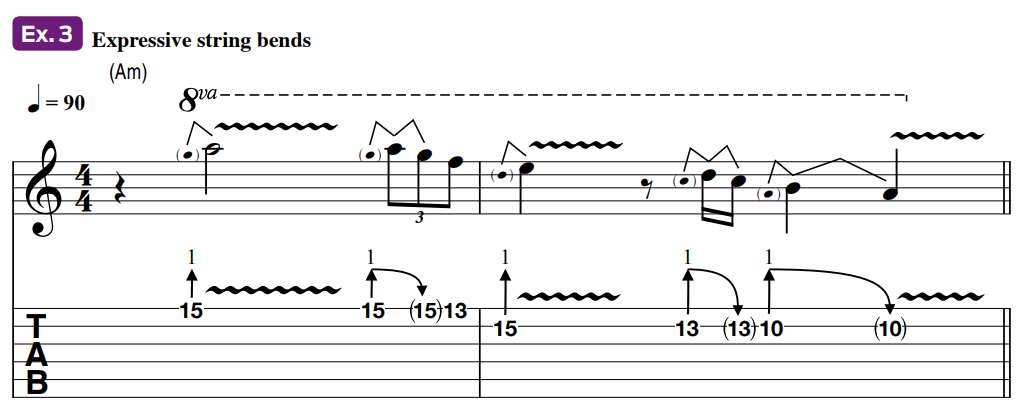
May is a master of using a pre-bend to add great expression to a melody note, as he does so beautifully throughout his solo in “Bohemian Rhapsody” (A Night at the Opera, 1975).
The lick in Ex. 3 similarly makes effective use of the technique. As its name implies, a pre-bend is performed by bending a note silently, before it is picked. This is indicated in the tablature by a straight vertical arrow above the fret number, and in the standard notation by a grace note enclosed in parentheses.
The technique takes a bit of practice to master, as you need to acquire the muscle memory to accurately anticipate the precise amount of push pressure to apply against the string in order to bend it up to the intended target pitch without the benefit of hearing what you’re doing until it’s too late – meaning until after you’ve already bent then picked the string, in that order.
And so it takes some trial and error for your ear and brain to train your fingers to feel and blindly respond to the string tension to achieve the desired result.
Each bar of our featured example begins with a pre-bend that is then gracefully shaken using the bend vibrato technique detailed earlier.
Mastering this technique is a key to copying Brian’s celebrated touch and style.
DELAY EFFECT FOR HARMONIES
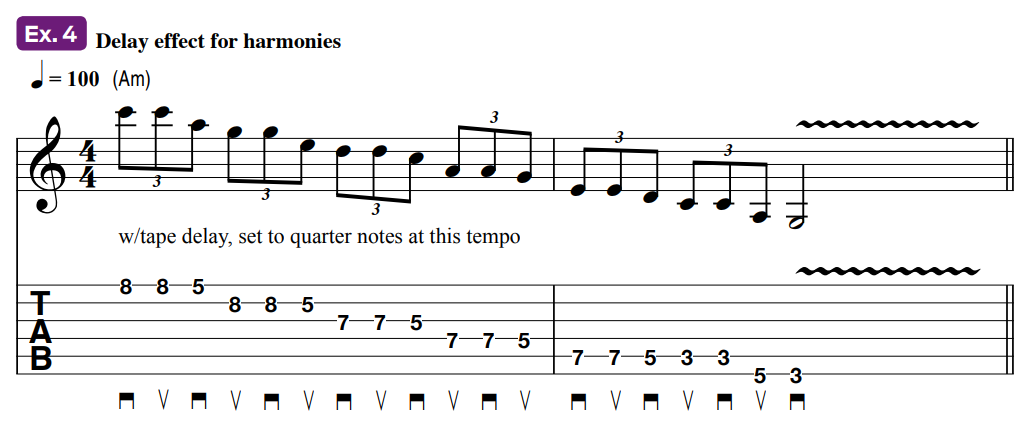
A signature effect-based trick that May is famous for employing brilliantly is the use of a delay unit to add either one or two prominent repeats, the timing of which the guitarist sets to match the tempo of what he’s playing, so that each note he plays echos in a pronounced quarter-note rhythm at the same volume.
May originally employed a Maestro Echoplex mechanical tape delay machine for this effect back in the 70s, most famously in his breakdown guitar solo in “Brighton Rock” (Sheer Heart Attack, 1973).
The trick involves playing an ascending or descending scale-based melody, with the echoed notes providing a rhythmically synchronized harmony to the notes played in real time, like a melodic canon, or round, as in “Row, Row, Row Your Boat.”
Set the rate, or speed, control on your analog or digital delay pedal accordingly for the lick shown in Ex. 4 to create a harmonious waterfall of notes.
BLUES INFLUENCE
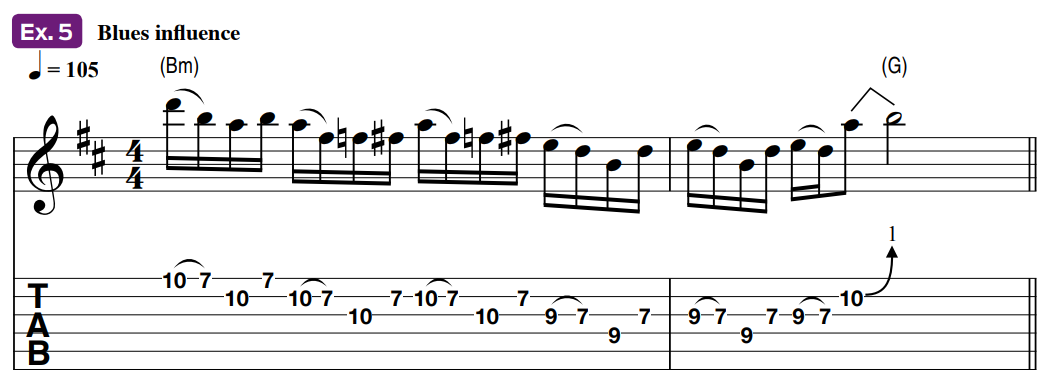
Inspired by May’s solos in songs such as “Headlong” (Innuendo, 1991) and “Dead on Time” (Jazz, 1978), Ex. 5 presents a descending lick that’s based on the B blues scale (B, D, E, F, F#, A).
Notice the cascading melodic contour, as the notes zigzag and work their way across the strings, and the use of a pull-off from the first 16th note of each beat, which creates a smooth legato articulation.
When pulling off, pull the string in toward your palm slightly as you let go of it, so as to pluck it slightly, which will keep the vibration going and maintain an even volume note to note.
The objective is the same as with the tapped pull-offs detailed earlier with Ex. 1. The only difference is that now we’re pulling-off from a fret-hand finger.
And, as always, be sure to pre-fret the lower note that you’re pulling off to, so that it’s ready to catch the pull-off.
ORCHESTRATING GUITAR LINES

Among his many talents, May is a skilled and accomplished audio engineer and producer who knows how to make great use of a multi-track recording studio to craft ambitiously orchestrated arrangements.
Inspired by the baroque-tinged “The Millionaire Waltz” (A Day at the Races, 1976), Ex. 6 will help steer you in new musical directions and think about effective ways to construct guitar parts.
Notice the use of arpeggios and targeted chord tones, as well as the contrast between sustained, vibratoed notes and quick triplet flourishes.
SCALE RUNS
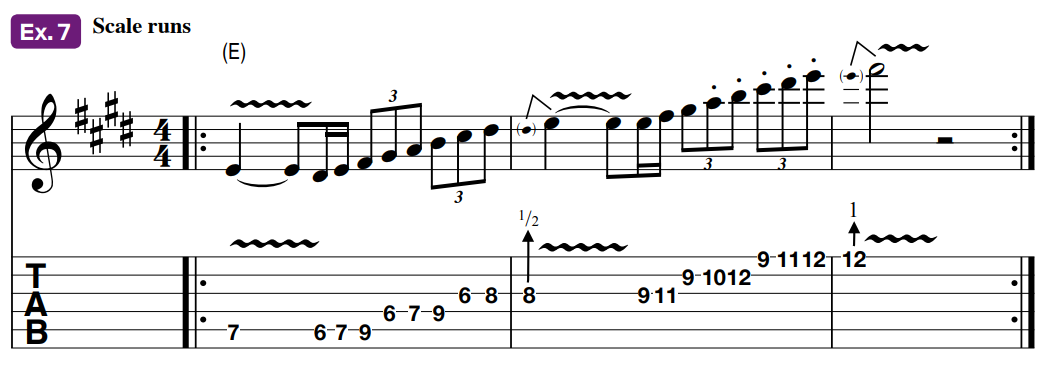
The lick in Ex. 7 is inspired by Queen classics like “Bohemian Rhapsody” and the Jazz cut “Bicycle Race,” two tracks that feature Brian playing long, winding scale runs.
You’ll need to learn some scale shapes to take the idea further, but this lick, which uses notes from the E major scale (E, F#, G#, A, B, C#, D#) will get you started. It’ll also help you improve your finger dexterity, and you’ll develop your ear too.
Again, note the use of finger vibratos, pre-bends and a position shift, in this case after the bend in bar 2.
Also noteworthy are the staccato articulations (indicated by the little black dots) leading up to the final note. These notes are to be muted with the fret hand immediately after they’re picked, to create a short, clipped sound.
EMOTIVE PLAYING
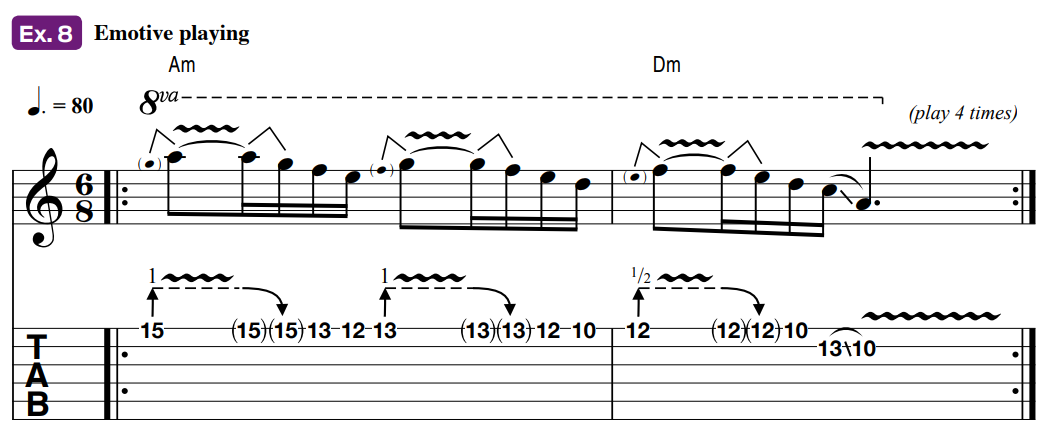
Brian’s playing can be incredibly emotive, as you can hear in tracks like “Who Wants to Live Forever” (A Kind of Magic), “These Are the Days of Our Lives” and “Bijou” (both from Innuendo).
For our final example (Ex. 8), you’ll use pre-bends and bend vibratos to emulate Brian’s magic touch.
You’ll need to shift your fret hand down the string for each successive bend, so that it is performed with the ring finger, supported one fret below by the middle finger.
Note that the first two pre-bends are whole-step bends (as indicated by the “1” in the tab), which is the equivalent pitch of an unbent note two frets higher, and the final pre-bend is only a half-step bend, matching the pitch of the unbent note one fret higher.
The phrase concludes with a legato finger slide down the B string, from C to A, for which only the C note is picked (as indicated by the slur connecting the two notes).
The A is gently shaken, then the whole sequence repeats, providing worthwhile practice for these invaluable rock lead playing techniques.
